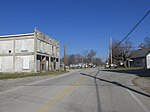Westboro, Ohio
Greater Cincinnati geography stubsUnincorporated communities in Clinton County, OhioUnincorporated communities in OhioUse mdy dates from July 2023
Westboro is an unincorporated community in Jefferson Township, Clinton County, Ohio, United States.
Excerpt from the Wikipedia article Westboro, Ohio (License: CC BY-SA 3.0, Authors).Westboro, Ohio
Main Street, Jefferson Township
Geographical coordinates (GPS) Address Nearby Places Show on map
Geographical coordinates (GPS)
| Latitude | Longitude |
|---|---|
| N 39.281388888889 ° | E -83.910555555556 ° |
Address
Main Street
Main Street
45148 Jefferson Township
Ohio, United States
Open on Google Maps









